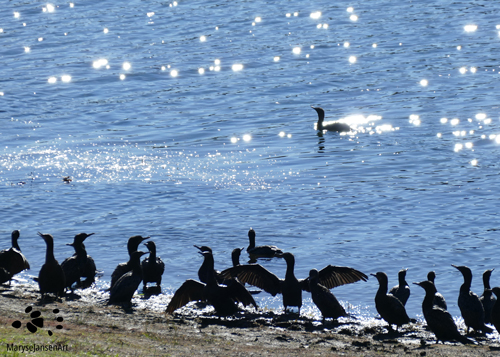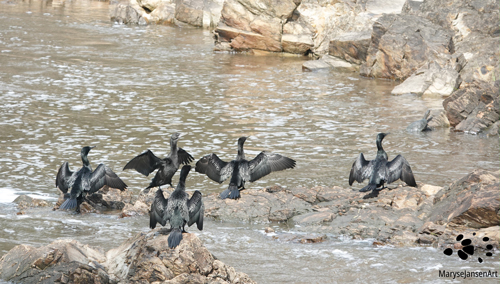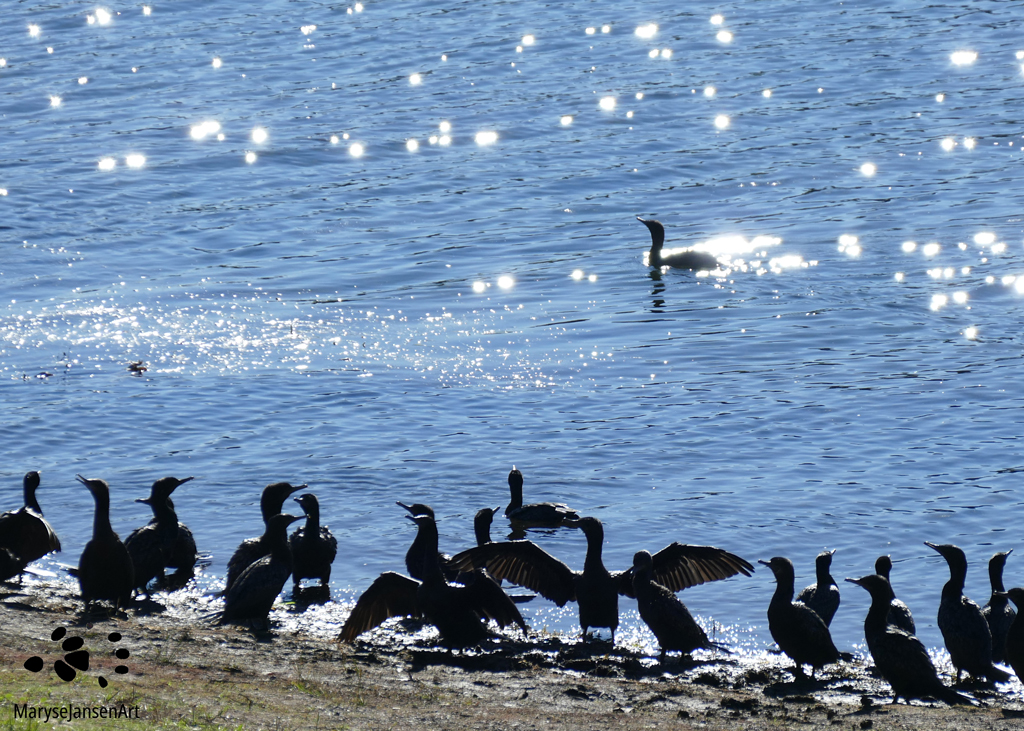Bird Photography with marysejansenart
A Water Bird that Loves Company

Table of Contents
Cormorants in Australia
It is one of those birds that is often being taken for granted, the Cormorant! This aquatic bird species can be found almost everywhere throughout the world, along coastlines and inland water bodies. Of about 40 different Cormorant species worldwide, 5 are found in Australia: the Black-faced Cormorant, the Pied Cormorant, the Little Pied Cormorant, the Great Cormorant and the Little Black Cormorant. The last one is the one I will discuss in this article.
The Little Black Cormorant can be distinguished from Australia’s other Cormorant species by the fact that this bird is all black. The Great Cormorant is also black but has a large yellow beak and white cheeks, and the other 3 species are all black and white. The Little Black Cormorant measures 60-65cm so it certainly a good sized bird. Like all Cormorants they have long necks, long tails and short legs with webbed feet.
The Little Black Cormorant is an excellent swimmer
Although they rest on branches of trees or rocks and boulders, these birds will never leave the vicinity of the water. While many species of Cormorants are mostly seen near salt water, inhabiting islands and coastal areas, the Little Black Cormorants prefer fresh water habitats such as lakes and streams.
They are more efficient swimmers then flyers. It is important that they can swim and dive well as they catch their prey underwater. On their menu are fish, crustaceans and aquatic insects. Their webbed feet help propel them under the water. To protect their eyes they have a special membrane that closes over it when they dive. (To read about another animal with webbed feet – and it’s not a bird – click here!)
The Little Black Cormorant likes company
These birds don’t like to be alone. They will at least be seen in a small group but can flock in large groups of hundreds or even thousands! At the lake today, I encounter a large group, I think there might be a couple of hundred birds.
Little Black Cormorants happily flock with other birds too, such as the Little Pied Cormorant. In this case they are hanging out with a couple of Pelicans and a good number of white Egrets. Like a class of little children the Cormorants seem to follow the large Pelican’s every move, which is quite entertaining to watch. Cormorants are actually related to Pelicans so it’s kind of as if they are taking the lead from a big uncle so to speak. They really behave like herd-animals: when one decides to take flight, suddenly they all take off. The same thing happens as soon as one of them enters the water: they all follow!
There’s a special moment when one bird enters the water. From where I am there is a beautiful reflection of the sunlight on the water, which makes it look like the swimming Cormorant is in the spotlight and there are lots of sparkles around it. The other birds are gathering up to follow, shuffling about and flapping their wings which makes them look like an audience, clapping and cheering for ‘The Star of the Show’! It makes for a great photo, which is shown in the featured image.
Catching Fish and Drying Wings
On another encounter a small flock has gathered along the spillway of our local dam. At first I spot them perched in the trees, about 200 metres away. They spot me too however and take off. I keep walking along the track and double back on the spot where I saw them. I have a better view here and I am less visible to the birds. I sit down and wait. They begin to return, tentatively at first. But when they feel safe they go on with their business which is fishing.
This is exciting! I get a really good look at these birds catching fish after fish. Very impressive how seemingly easy it is. They swim and dive down from the surface of the water when they spot their prey. They catch the fish with their beak and come back up to the surface to swallow it whole. It’s a really good fishing spot as I see them catch many fish in rapid succession!
When they have a rest, they climb up on the rocks in the water and perch with their wings spread out. Their feathers are not waterproof which is the reason you will often see them perched with their wings spread wide so they can dry after fishing.

Did you spot the turtle in the image above? It’s a Brisbane River Turtle!
Little Black Cormorant Breeding Habits
When you have a chance to study the Little Black Cormorant more closely you will see that they have beautiful green-blue eyes and that the feathers on their back have a greenish shine! In breeding season, this greenish shine becomes more bronze which gives the feathers on the back a scaled appearance. In addition, they develop thin white feathers on the head and the side of the neck to complete their breeding-plumage.
The Little Black Cormorants breed in colonies, often with other birds such as Little Pied Cormorants and Darters and near Herons and Ibises. They build large stick nests in trees or bushes, and line them with grass, bark and leaves. Both sexes work together on building the nest, incubating the eggs and feeding the chicks. A clutch of 3-5 (occasionally 6-7) pale blue eggs is laid. It takes about 1 month for the eggs to hatch. The chicks are hatched naked and grow black down. After about 2 months they are ready to fledge but they may still be fed by the parents for some time after that.
Check out below the latest episode in my ‘Come for a walk in the Australian Bush’-series, featuring the Little Black Cormorant and some other interesting birds!
If you are interested in purchasing ‘The Star of the Show’ or would like to see what the image looks like on the various products, please head to my shop. If you prefer ‘Little Black Cormorants Drying Their Wings’, click shop here.


